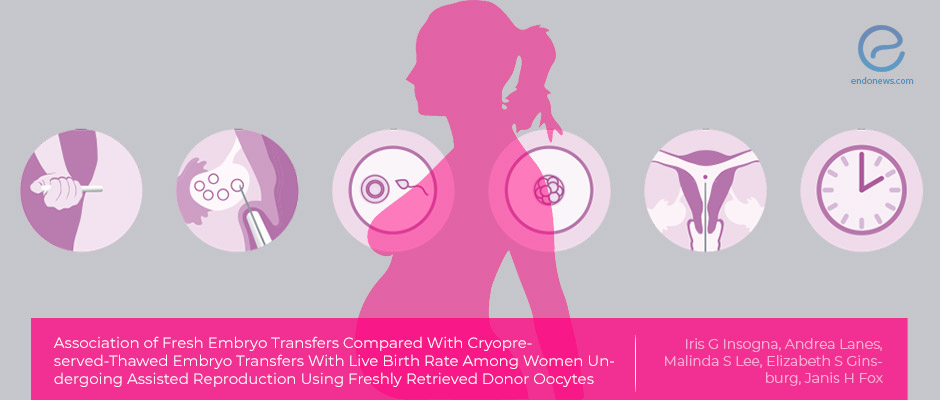Live Birth Rate in Women Who Underwent Fresh Embryo Transfer Using Freshly Retrieved Donor Oocytes
Feb 2, 2021
Higher live birth rates can be obtained in fresh embryo transfer compared to cryopreserved-thawed embryo transfer.
Key Points
Highlights:
- Fresh embryo transfer using freshly retrieved donor oocytes has a higher live birth rate for infertile women undergoing assisted reproduction treatment.
Importance:
- Fresh embryo transfers using freshly retrieved donor oocytes provide higher live birth rates compared to cryopreserved-thawed embryo transfers in women with any etiologic reason of infertility including endometriosis.
What’s done here?
- Infertile women who underwent donor oocyte cycles between 2014-2017 in the Society for Assisted Reproductive Technology were included in this retrospective cohort study.
- Live birth rate was the primary outcome and defined as delivery of one or more live-born infants.
- The rates for clinical pregnancy, defined as intrauterine gestational sac visualized on ultrasound, or documentation of live birth, miscarriage, or termination; and miscarriage, which is the loss of an intrauterine gestation prior to 20w, were secondary outcomes.
- Assisted hatching (creating a small opening in the zona pellucida to take a biopsy or to facilitate the implantation of an embryo) was also assessed.
- Patients who underwent fresh embryo transfer cycles and cryopreserved-thawed embryo transfers were compared in terms of demographic characteristics and clinical outcomes.
Key results:
- A total of 15 308 fresh embryo transfer cycles and 36 634 cryopreserved-thawed embryo transfer cycles were compared, groups were comparable in terms of age, gravidity, parity, and BMI.
- Endometriosis as a cause for infertility was comparable between groups (5.2% vs 4.7%, respectively).
- Assisted hatching was more common in the cryopreserved-thawed embryo transfer group compared to the fresh embryo transfer (70.2 vs 22.9%, respectively).
- The live birth rate was significantly higher following the fresh embryo transfer group compared to the cryopreserved-thawed embryo transfer (56.6 vs 44.0%, respectively).
- The clinical pregnancy rate was also significantly higher after fresh embryo transfer compared to the cryopreserved-thawed embryo transfer (66.7 vs 54.2%, respectively).
- The miscarriage rate was not different between groups.
- Preimplantation genetic testing for aneuploidy was performed most frequently in cryopreserved-thawed embryo transfer (89%).
Strengths and Limitations
- The large sample size and assessment of live birth rate as the primary outcome is the major strength.
- Retrospective design and the inability to control all potential confounders on live birth rate due to missing data is a limitation of the study.
- Cycles from the same donor across different recipients were not evaluated.
- Only the initial embryo transfer in each recipient was assessed although recipients may have undergone more than one embryo transfer within the specified time period.
Lay Summary
One of the important clinical findings in women with endometriosis is reproductive problems. Infertility can be encountered in up to 50% of women with endometriosis and up to 50% of women with infertility can be diagnosed with endometriosis.
Several pathophysiologic mechanisms have been proposed for the development of infertility in endometriosis patients, such as anatomic distortion, alterations in endometrial receptivity, diminished tubal peristalsis, and sperm movements. Assisted reproduction technology is the most frequently preferred treatment approach in women having endometriosis.
The cryopreserved-thawed embryo transfer during assisted reproduction has an increasing preference because of convenience, elimination of the need for synchronization between donor and recipient cycles, and/or increasing utilization of preimplantation genetic testing for aneuploidy. It was assumed that a higher live birth rate in the cryopreserved-thawed embryo transfer cycles compared with fresh embryo transfer is another reason for this popularity.
However, all of the studies to evaluate Assisted Reproduction Technology success have been performed during in vitro fertilization cycles using autologous oocytes.
Dr. Insogna et al, from the Department of Obstetrics and Gynecology, Brigham and Women’s Hospital, USA, recently published a study titled “Association of Fresh Embryo Transfers Compared With Cryopreserved-Thawed Embryo Transfers With Live Birth Rate Among Women Undergoing Assisted Reproduction Using Freshly Retrieved Donor Oocytes” in the "Journal of American Medical Association". The authors aimed to assess live birth rate as the primary outcome in fresh embryo transfer compared with a cryopreserved-thawed embryo transfer using freshly retrieved donor oocytes.
They also investigated clinical pregnancy rate and miscarriage rate. Study groups were similar regarding age, gravidity, parity, and body mass index. Endometriosis is a common etiologic reason among the participants. Live birth rate and clinical pregnancy rate were found to be significantly higher in fresh embryo transfer using freshly retrieved donor oocytes compared to cryopreserved-thawed embryo transfer. The miscarriage rate did not show a significant difference between the two groups.
“The use of fresh embryo transfers compared with cryopreserved-thawed embryo transfers was associated with a higher live birth rate. However, interpretation of the findings is limited by the potential for selection and confounding bias” the authors added.
Research Source: https://pubmed.ncbi.nlm.nih.gov/33433574/
endometriosis infertility live birth rate clinical pregnancy rate miscarriage rate fresh embryo transfer cryopreserved-thawed embryo transfer donor oocytes assisted reproduction technology in vitro fertilization

